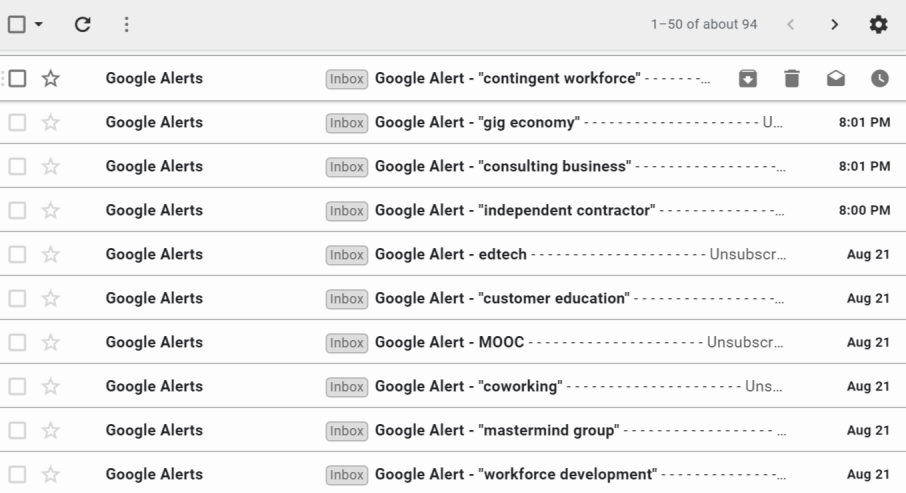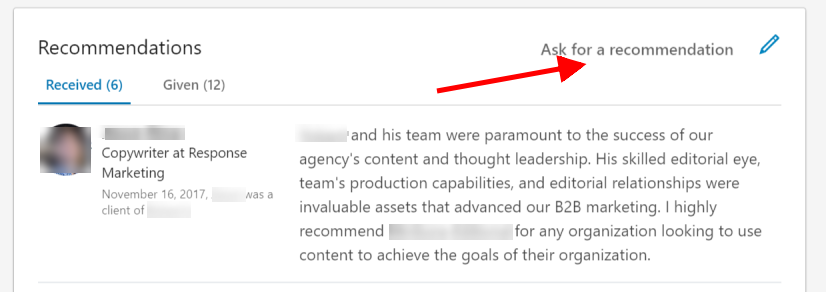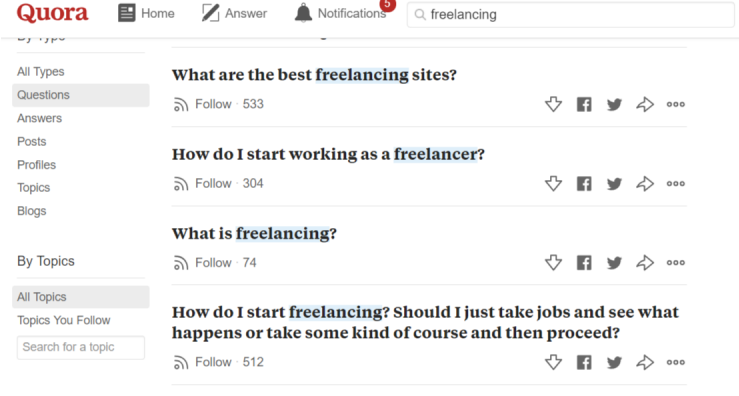Attracting new clients can be intimidating for new freelancers. Networking feels unnatural for many us, and we often don’t know how to build the referral networks and healthy pipelines of new clients.
But here’s the thing about going freelance and treating it like a real business . . . . It takes hustle, and lots of it. You are essentially a mini startup company of one.
We’re confident that if you grind through this initial phase, you will develop a pipeline of prospective clients that give you the kind of career you desire.
Ready to start?
In this guide you will find powerful strategies that will help you:
- Understand which prospective new clients to focus on.
- Build relationships that lead to high quality referrals.
- Find the time to make these things happen, little by little.
Much of this summarizes extensive advice in other articles, so think of this as an overview, and be sure to click through to the other articles for more in-depth advice on finding new clients.
Also, while you’re at it, don’t miss the replay of this livestream event where Ed Gandia advises Nation1099 visitors on getting better clients.
More Clients or Better Clients? How To Shift Gears As A Freelancer
1. Think in terms of channels
One basic approach to marketing in general is to “put your hook where the fish are swimming.” What channels do your prospective swim in? Where do they get information, spend their free time or do their work?
After all it does no good to put an ad for your freelance services on the side of a bus if the new clients you are hoping for work from home.
Thinking in terms of channels will keep you from chasing every new shiny object to add to your marketing toolkit. For example, several of our tips below are about using email. But you should always pause for a reality check. Do your prospective new clients actually use email? That may be a channel full of fish but not the species of fish you in particular are going after.
Ditto when anyone advises you to chase new clients on Pinterest, on message boards, with Facebook ads, etc. Check that idea against what you know about the channels your prospects use. Those channels may be “popular” but still not where your new clients will be.
Start by sketching out what you know about your clients and channels like these:
- Social media
- Live events
- Online events
- Print media
- Online video
- Blogs
- Forums
- Courses
2. Set real time aside for business development
At Nation1099, we talk with a lot of freelancers and consultants to find out why they aren’t attracting new clients.
The number one reason?
Just not budgeting the time for it.
Many of us see marketing as extra work because it’s time not directly serving our clients.
The only way to grow and to find higher paying clients is to spend time on the business as well as in the business.
You have to put your clients aside for some fraction of your time and work on getting the clients you don’t have yet.
Let’s start with one hour in your work day.
Feel like you need the whole day to get your client work done? Then you need to be set the alarm one hour earlier or stay up an hour later. Or put in a couple of weekend days a month.
Once you have regular times blocked out, then the rest of these hacks are going to go a lot more smoothly.
3. Develop a clear client profile
Before we get too tactical, let’s pause to do just a little bit of planning.
After all, you can’t grow your business if you don’t know who you are trying to serve.
“It could be anyone,” is not a useful answer to this question If you treat prospective clients like a commodity — one as good as another — your services are going to get priced like a commodity.
A client profile is a short specific summary of your target client. By creating a vivid picture of the people and businesses you most want to work with, you unlock the ability to speak directly to their needs.
A client profile helps you stop making rookie mistakes like claiming to be an all-purpose, full-stack generalist who “specializes” in a list of industries longer than a tax form.
We put together a guide dedicated to determining your client profile. You can get the complete guide with the button below, but this is the process in summary:
- List the positive and negative traits of each of your current and past clients.
- Describe their brands.
- Synthesize it into a short master list of the traits of your ideal client.
Working through those exercises, you may identify your ideal client as something like:
- Online learning startups with Series B funding
- Individual sellers of informational products
- Consumer packaged goods companies still in early growth stages
- First-wave SaaS companies
- Family-owned manufacturing businesses
That last one is a real example from a successful freelance copywriter we used in an in-depth guide to developing your freelance brand.
With a clear picture of your specific niche, take a few hours to build a list of businesses you would love to have as new clients. Twitter and local directories are good places to start your research.
If your ideal clients are startups, try Crunchbase to get more ideas.
Google alerts are also a great way to find new prospects and to get developments about who is working in your niche.
For example, if your dream client is a “biotech startup,” then a Google alert with that keyword will let you know who is getting funding or launching new products. Use the settings in your Gmail to mark these all as read automatically when they come in and to go to their own folder. That way they don’t overwhelm your inbox.
Then you have a daily digest of industry news that will let you learn more about your ideal clients.

Quora is another excellent place to lurk to find out more about your ideal clients. For example, if you search “biotech” because that’s your target niche, you find a section on biotech companies, with hundreds of questions, thousands of answers by people using their real names and titles and 25,000 followers.

Next, you need to find the right person within the company to engage with. When you are more established, you can budget for a virtual assistant work on this for you, but in your startup phase, you will have to grind it out.
For more on developing your freelance brand, check out this episode from our livestream series:
4. Send personalized emails to your target clients
With your client profile and a contact list in hand, you are ready to start trying some growth hacks. The first one is “warm prospecting.”
This is the alternative to cold calling or cold emailing. Warm prospecting means identifying people who fit your profile and reaching out in a non-spammy way to start a relationship.
With your prospect list growing, take an hour each day to research more deeply into just one. Then send out a single, solid, personalized email.
Your goal here isn’t to make a sale. It’s to start a relationship that may pay off later.
An hour to send craft and send one email? That may not seem very efficient. But you are trying to stand out from all the spammy pitches they get. You want to find a way to be helpful.
After all, these aren’t random people you are contacting. These are your ideal clients. If after 30 days just a couple of them have responded favorably, the effort will have been worth it.
The Google alerts that you set up will remind you of possible reasons to reach out to your prospects. When you see news about someone in your niche winning awards, getting press mentions or putting out surveys, think about who on your prospect list you can send that to with a short note.
Another reason to reach out is when you see industry news they might not be aware of, such as a report or study that your Google alerts bring to your attention.
5. Ask for referrals to find new clients
Referrals will not happen if you don’t ask for them, so be proactive!
There is no reason to be afraid of politely asking your current clients for referrals. They will understand you are running a business and that this is not an “exclusive relationship.”
At the right time, simply say with confidence, “I’m in a prospecting phase right now, and I’ve really enjoyed our work together. Do you have colleagues at other companies who might need my services?”
You can ask this after a contract renews or at some natural pause point. You can even bring it up during one of your regular check-in calls. Offer them time to think about it and say you’ll check back on the next call.
Another great time to bring this up is when your relationship is ending, assuming that it is on good terms.
For example, if you are completing a project, just say, “It’s been great working with you. During this wrap up phase, can you take a few minutes to talk about who else you know who might need my services?”
Oftentimes, your contacts will be willing but when they are put on the spot they have trouble thinking of anyone to recommend. You can prompt them by telling them about your ideal client that you identified earlier. That should be enough to remind them of contacts they have who you should talk to.
Try this: If your client is going to send an introduction between you and a prospective client, make it easy for them. Even though this contact knows you pretty well, write up your own blurb about who you are and what you do, and put that in the inbox of your contact.
6. Take a more critical look at your website
Too many freelance websites read like first drafts. The site isn’t clear about who the freelancer serves and how.
The biggest mistake is trying to come off as all things to all people. Speak to your ideal clients and make sure when they land on your site they recognize themselves and their problems in what they read there.
Most freelancer or consultant websites should have has these three essentials:
- A clear call to action. What do you want visitors to do when they get there?
- Very high quality samples of work. Do your samples speak to the concerns of the ideal client you outlined above?
- A blog that demonstrates expertise. Does your website offer content that meaningfully educates your prospects and shows your qualifications?
To see some excellent examples of websites that make all of this clear, check out this slideshow of great freelance branding.
7. Add testimonials to your website
Client testimonials make your website pop, and it’s not that difficult to get them.
First, look at anything kind that clients and colleagues may have already said about you. If a client ever sent you a high five by email, dig it up and just ask if you can include it on your website.
If it was in first person (i.e. “You did a great job.”), revise it into third person yourself (“Jane did a great job.”), and show your client that version for approval.
You might even just take a screenshot of the note and put that on your website.
Second, use the LinkedIn recommendation feature. Make sure you are connected to current and former clients and send them requests for recommendations. Then simply take the most relevant recommendations that you do get and add them in the form of quotes on your site.

Lastly, directly contact anyone who is essential to your testimonial page. Explain that you are putting together testimonials that will speak to your ideal clients, and ask them to reply back by email with a few words that you can quote on your website.
Don’t forget to send the same requests to former bosses and colleagues from your days as a traditional employee.
Try this: Guide your endorsers on what to talk about. Many people don’t know how to deal with a vague request for a recommendation. When you contact someone for a recommendation, tell them which skills you want to emphasize. That will give them a running start on what to write about in their testimonial.
8. Create a referral program to attract new clients
If you feel your clients need a little push to help you grow your business, you may want to create a referral program.
Determine an incentive that is reasonable for your business. Do your customers save $25 on their monthly fee for each new client they refer? Is it $100 for very high value clients? Do you simply give them a free keyword evaluation of their website or set them up with a new email marketing platform?
Whatever the case, use the needs of your client profile to guide your referral program. Give them something you know they want!
Just remember: Don’t give away more money or time than you can afford to part with. Your referral program needs to be be cost effective for your business.
9. Turn your sales stage into a product you charge for
The initial consultation with a prospective client can be very frustrating for freelancers. You can see hours of time gobbled up with no billable work to show for it.
You’ll learn over time that many prospects who contact you are “tire kickers” with no intention of buying. They are just gathering pricing information to plan their budget, or they want free coaching on a process they will use themselves in house.
If you’re getting bogged down in sales calls with the wrong kinds of prospects, try a different approach by turning the process into a product.
For example, suppose your minimum contract is $5,000. For $1,000 you could offer a completed plan of some kind, depending on the services you sell. It might be a web site audit, a creative brief, a preliminary marketing strategy or a branding audit.
This has a few benefits. First, it weeds out the tire kickers. This is called “pre-qualifying” your clients. You are only spending time on prospects who you know are serious and who have a budget.
Second, it helps prospective client see the value you can provide them. For a fraction of your minimum, they learn more about how you work and what you’re capable of. That makes each prospect much more likely to convert into a full-fledged client.
Our colleague Jayne Heggen calls this tactic the “low-cost sell-in” in a Q&A session she did on pricing freelance services.
How To Productize Services As a Freelancer: Tips From Industry Leaders
10. Optimize for the right Google traffic
Too many people make the mistake of optimizing for keywords by just two criteria: what has the highest search volume and what they can compete for.
They leave out a critical third factor, which is alignment with your customer profile.
There’s no point getting to page 1 on a Google search made by 10,000 people per month who have no intention of buying from you.
Adding the ideal customer profile to your keyword research takes another layer of analysis. You need to go to where your prospective clients are and observe what questions they are asking. Creativity counts here, but here are a couple ideas.
One, visit Quora, find the threads where your prospects hang out and understand how they discuss their industry. That’s a more organic way to find what to optimize your website for.
Two, go to Amazon, find the books your prospects are buying and mine the meta data on those books. The table of contents, for example, can make a great list of ideas of what you should optimize for.
11. Send content-driven follow up emails
Follow up emails can be incredibly effective if you know what you’re doing. “Hey, just checking in” doesn’t work. Don’t send those.
A great follow up email adds value to your prospect’s day. Find the latest studies, white papers or podcasts that are relevant to your network of prospects. Then show them that you have your finger on the pulse of your industry and that you understand their business problems by sharing that content.
Don’t forget to include your current and former clients in these contacts to keep the relationship warm.
For example, your email might say something like, “I noticed the data in table 4 on page 11 in this study. It reminded me of your comment to me about the trouble your team is having in this area. I thought this might interest you and your colleagues.”
Make sure that you avoid an obvious sales pitch in this email. You should, however, tell them to contact you if they have any further questions about the guide or the topic.
12. Raise your prices and offer new service packages
Adding on to that last point, if you’ve successfully re-established contact with a stalled lead, and they’ve demonstrated interest in your services, make sure you present them with a higher rate and new service packages or offerings in your scope of work.
It’s important to show on-going prospects that your value and skills have increased in the time since your first communications. This is also a great way to test new pricing packages in a low-risk way.
13. Create and deliver free how-to videos with Google Hangouts
You do not need to have a TED Talk in your resume to be a thought leader.
If you put develop a clear presentation, a how-to video can be an extremely effective way to demonstrate expertise to new clients and to put them at ease about hiring you.
Remember, at a certain point, a prospect will be in the consideration phase, and their main questions will be what it will be like working with you and if you will really deliver the value you promise. A video that is genuinely helpful can reassure prospective clients on both of those questions.
Try this: Youtube bumps you to the top of their tag searches when you go live with your webinar, so make sure you add the appropriate tags to your live stream webinars.
14. Organize or participate in local events
If your ideal clients live in your region, you need to think about local events. While we may do most of our freelance work remotely, meeting prospects in person gives us the opportunity to stand out.
Create a concise lesson that helps your target clients handle (or at least be better informed about) a topic you know stresses them out. Be creative about where and how you can do this. I’m a big fan of PechaKucha presentations. Your local library or Community Foundation may have a series of small business or professional development workshops that you will be welcome to present at.
15. Join a coworking space
Freelancers need other freelancers, and the highest value work for clients usually requires collaboration. Where do freelancers go to find collaborative environments and new network contacts?
Coworking spaces, of course. If you’re having a hard time breaking into your local business community, spend some time in the different coworking spaces.
Many coworking spaces host presentations and other networking events for members and for guests. The evenings, happy hours and lunch hours at a coworking space may turn out to be as valuable as working hours.
Do a quick search for coworking spaces in your area, then make an effort to try out a new one each month.
Find and Choose the Best Coworking Spaces For Your Freelance Work
16. Join a mastermind group
In addition to being a great way to keep you accountable, mastermind groups can get you new clients. They often result in richer networks of peers who can refer you to new clients.
Your mastermind group also provides a network of reliable collaborators who you can call on when projects require another set of hand.
Likewise, you may be the the first call another member of the mastermind group makes when they need a subcontractor for their client work.
If you’re new to the idea of the mastermind group, we’ve got all the info you need to find, organize, run and create your own below.
How to Find a Mastermind Group for Freelancers . . . Or to Start and Run One Yourself
17. Guest post strategically
Guest posts can be a great tool for building online relationships, brand credibility, direct traffic and search engine traffic.
Guest posting is a time consuming process, so it’s important to pursue outlets and opportunities that will add value to your brand.
The biggest mistake people make with guest posting is that they get too caught up in the value of links to their SEO efforts. They forget that guest posting is foremost a chance to make a positive impression.
The best way to approach guest posting is to forget about Google and to concentrate on the direct traffic the article could get you. In other words, instead of trying to compete on quantity (How can I spin this article into as many guest post links as possible?), compete on quality.
As I’ve written elsewhere, that means you should aim to write a guest post so fantastic that readers will ask themselves, “Who is this person? How do I find out more about them?”
When it comes to guest posting, conversations are worth more than links. If it doesn’t inspire people to actually talk to you, then you’re missing the real opportunity.
18. Wherever there’s a question, be the answer
What kinds of problems and frustrations are your prospective clients talking about on social media and in industry forums?
Wherever these dialogues are happening, make sure you’re there too and ready to deliver expert advice.
How do you find these places? Try these two searches on Google:
- [client industry] forum
- Questions about [client industry]
Naturally, as we’ve covered above, make sure to check out Quora forums and LinkedIn groups also. Then make it a regular habit to check in and contribute in very helpful ways on those forums. Your goal is to build a reputation as someone who knows their stuff.
For example, here is a very basic search on Quora that results in hundreds of natural language questions:

A big chunk of Nation1099’s organic traffic comes from regularly answering questions there. And we know many freelancers and consultants who use the same strategy to make an impression on the prospective clients in their target market.
19. Apply to a high level freelance marketplace
Freelance marketplaces have a reputation for low-value gigs with too much competition from people willing to work for low rates.
If you haven’t checked in on freelance gig platforms lately, there has been a lot of innovation that may present an opportunity for you. Many new freelance marketplaces promise to be more exclusive — about the talent they let in and about the jobs that get posted.
Some of them charge you up front to be featured prominently, but it only takes a couple great clients for that to pay off.
Nation1099 maintains lists of the most interesting new freelance marketplaces.
Keep the pipeline flowing
Wait-and-see is such an easy mistake to make.
We’ve all had that “great call with a prospective client” after months of courting them. They end the call saying they’ll talk to their colleagues and get back to you after the weekend.
It’s tempting to start planning all the work you’ll do for this new client instead of keeping your head in the game. Successful freelancers forget about those great calls until a contract is signed. They return right away to the slog of finding new clients.
After all, even if that great prospect signs a contract on Monday, you’re going to want an even better client after that, so you have to get the pipeline flowing.
Business development can’t be something you do only in lean times. It needs to be a consistent and focused effort, but it’s entirely doable if you break this work into small pieces. Keep at it with the 15 tips discussed above, and eventually you’ll see the individual efforts come together into the sustainable freelance business you deserve.





